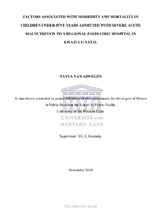| dc.description.abstract | Background: Malnutrition is a complex condition profoundly impacting child mortality and morbidity,
especially in sub-Saharan Africa. Severe acute malnutrition is of growing concern locally where
unacceptable mortality rates persist, despite reasonable standards of clinical care.
Aim: To determine factors associated with morbidity and mortality in children under-five years admitted
with severe acute malnutrition to a regional paediatric hospital in KwaZulu-Natal.
Methodology: This was a quantitative study. A retrospective observational study design was used. Medical
records of all children with severe acute malnutrition, under the age of five years, admitted between April
2015 and December 2016 to the regional paediatric hospital in KwaZulu-Natal were included. Data was
obtained from medical records and admission books. A trained research assistant was used to extract and
record data with a piloted data extraction tool. Data was entered and cleaned using Microsoft Excel and
analysed using SPSS (v 20) and STATA (v 14). Descriptive summary statistics were used to describe the
characteristics of the study population and bivariate analysis using t-tests and Chi-square tests to determine
significance. Kaplan Meier and Multivariate Cox regression was used to assess the association of variables
with morbidity and mortality.
Results: Of the 276 eligible case records included in the study, 54% were male and 90% of all cases were
younger than 2 years. Even though associations did not reach significance, teenage pregnancy and
unemployment was high amongst the caregivers of the study population. Most of the malnourished children
admitted (74%) presented with multiple comorbidities. Diarrhoea (43%), HIV- infection (30%) and
respiratory tract infections (30%) were the top three comorbidities found, followed by tuberculosis (27%).
The overall mortality rate was 8.7%. Survival probability was significantly reduced in children with
pneumonia and those who presented with hypoglycaemia, dehydration, dermatosis, severe pallor, altered
consciousness or shock on admission (p < 0.05). There was a significantly increased risk of death in males
(HR = 0.174, 95%CI = 0.05 - 0.665), and in those who presented with dehydration (HR = 4.1, 95%CI =
1.25 - 13.59), evidence of lethargy or coma (HR = 4.2, 95%CI = 1.04 - 17.12) or multiple clinical signs
(HR = 4.4, 95% CI =2.56 - 7.59) on admission (p < 0.05). The comorbidities HIV-infection (HR = 9.9,
95%CI = 1.39 - 70.68) and pneumonia (HR = 3.4, 95%CI = 1.56 - 7.43) showed a significantly increased
mortality risk (p < 0.05).
Conclusion: This study supports the body of evidence that despite reasonable standards of hospital care, it
is difficult to obtain the target for severe acute malnutrition mortality (< 5%), likely due to the presence of
contextually specific factors. Local interventions at hospital, primary health care and community level is
needed, as well as further research to facilitate comprehensive policy-making. | en_US |

